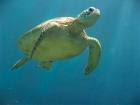Those that live and thrive on land are called tortoises, and those that live in sea, rivers, ponds, or any body of water are called turtles by zoologists. Both are different and distinct species. Turtles typically have broad legs serving as flippers that allow them to swim efficiently underwater. An interesting species of sea turtles known as the leatherback can weigh up to 800 kilograms, but because of its large flippers, it can attain a speed of 35 kilometers per hour underwater, and there are no other sea turtles that can match its speed in swimming and deep diving.
A biologist named Scott Eckert carried out an experiment in 1987 to determine the depth up to which a leatherback turtle could dive. Dr. Eckert tied a pressure gauge on a leatherback to monitor how deep it can go down the body of water. After securing the turtle with a thin wire, the biologist released it in the sea near the Virgin Islands located in the West Indies. This turtle descended up to a depth of 1,200 meters (approximately 3,973 feet), which is an astounding feat for its species.
The bodies of giant leatherback turtles contain large amounts of fat, and the amount prompts them to grow bigger than most turtles in the world. Because of the excessive fat in their bodies, no museum can display a dead body of such a sea turtle because the fat in its body will continue to drip for almost fifty years. The decaying smell of the fat will then fill the entire museum with its stink. On the other hand, freshwater turtles are not large and are much smaller compared to leatherbacks. These turtles measure for about 1.5 to 2 feet maximum in length and 63 kilograms or 140 pounds maximum in terms of its weight.
Most turtles have a softer and lighter shell compared to tortoises, and the patterns of their shells are typically more streamlined or simpler. Their flippers are actually webbed feet that have long claws at the end. They normally eat both meat and plants, making them herbivores. The average lifespan of a turtle is 30 years, although there are some cases where they have lived for more than 80 years. Almost all turtles are found in the seas of America and Africa.
Land-dwelling tortoises, unlike aquatic turtles, possess short legs that are thick and bulky. Because of how short their legs are, these tortoises move slowly inland, making them helpless against agile predators. However, several large-sized species of tortoises have found safe habitat on remote islands, such as Galapagos, Aldabra, Seychelles, and Mauritius. These islands allow the tortoises to live in peace since there are no animals fast and strong enough to prey upon them. Because of having no prey in these areas, they are able to live longer lives.
Besides their legs, the tortoises’ shells are also bulkier and heavier than those found in turtles. In addition, the shells also have a more intricate pattern, with some even having spike-like bumps near the edges. While turtles are omnivores, most species of tortoises are herbivores, mainly due to them not being too slow to hunt for prey. However, there are some species that are capable of hunting, but they are only a few of them in the wild. Like turtles, tortoises can be found in Africa and America, although there are a few found in Asia.
The largest tortoises (250-300 kilograms in weight) inhabit the island found in the Indian Ocean called Aldabra, and they enjoy their long life for up to 150 years, which is more than double of a human’s lifespan! In fact, the oldest living tortoise that was reported by zoologists is approximately 185 years old. This old tortoise is named Jonathan and is living since 1882 in Saint Helena, an island located in the South Atlantic Ocean. However, it is speculated that Jonathan is already 50 years old when he was brought to the island, as he originally came from Seychelles, an island country in the Indian Ocean.
Can Sea Turtles Live on Land?
Despite the popular belief that sea turtles can only live in the sea like their name suggests, they actually need to breathe air, so they would sometimes rise up to the surface of the sea and get fresh air, or they would even explore nearby islands not only to get oxygen but also to get some rest since they would constantly have to move if they are underwater.
Unfortunately for tortoises, since they don’t have flippers, they are usually stuck on land. However, if they have no choice but to go to a body of water, they will swim, although they are rather floating than swimming on the water’s surface.
Most people often mistake tortoises to be the same species as sea turtle, which is why some of them would place a rescued tortoise in a body of water rather than on land. Because tortoises did not evolve to swim on the water, a few of them would drown if they are returned to the sea. There have been many reports of tortoises drowning because people mistake them as sea turtles when rescuing them, so if you ever see an animal with a turtle shell that looks lost, make sure to identify first if it has either flippers or stumpy feet before rescuing them or returning them to a safe habitat.
Related posts:


